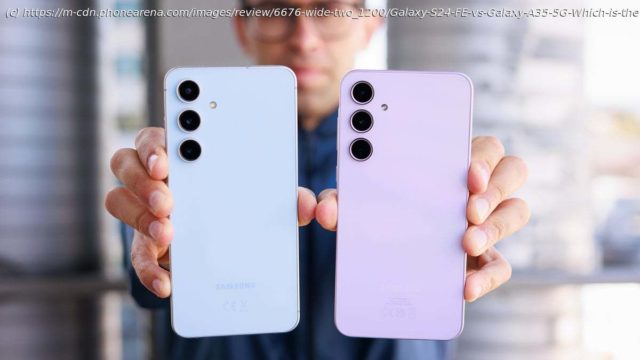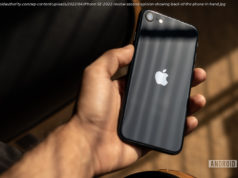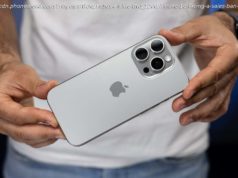Samsung’s own mid-range battle: The Galaxy S24 FE vs. A35 5G—a closer look at their differences and similarities.
Intro
The Galaxy S24 FE is a device that aims to offer flagship-level performance and features at a more affordable price. The FE sits right between the Samsung’s flagship Galaxy S24 series and its mid-range Galaxy A series. But how does it compare to the Galaxy A35 5G, which is one of the best-selling mid-range phones from Samsung?
In this comparison, we will take a close look at the Galaxy S24 FE and the Galaxy A35 5G to see how they stack up against each other. We will compare their design and display, performance and software, camera, battery life and charging, and specs.
We were quite surprised by some of the differences between these two Samsung mid-rangers. The Galaxy S24 FE is definitely more expensive at a $250 higher starting price, but showcases a staggering jump in performance thanks to the new Exynos 2400e chip inside. The A35 5G, on the other hand, somehow still manages to prove its worth as a more affordable option.
The Galaxy S24 FE is priced at $649 in the US, while the Galaxy A35 5G is priced at $399. Both phones are available for purchase from Samsung’s website and major carriers.
Galaxy S24 FE vs Galaxy A35 5G differences:
Galaxy S24 FEGalaxy A35 5G
Slightly larger and heavier Comes in somewhat smaller so it might be easier carry
Much larger display (6.7″) with considerably thinner bezels Display is smaller (6.4″) and has thicker bezels
Display gets brighter and is more visible in highly-lit environments Display is still plenty visible in normal scenarios but can be difficult to see sometimes
Processor is almost twice as powerful and is better at gaming Processor is powerful enough for regular gaming titles but cannot handle more demanding ones as well
Larger battery, potentially resulting in longer battery life Smaller battery, although not by much
Same camera system, but might have improvements to the post-processing Camera hardware is pretty impressive for this price point
Table of Contents:
Design and Display
Performance
Camera
Battery and Charging
Specs
Summary
Read more:
Galaxy S24 Hands-On Preview
Galaxy S24 FE vs Galaxy S24: You might not have to get the flagship after all
Design and Display QualitySame look, but better tech and durability
The S24 FE and A35 5G are actually quite similar in terms of their shape and form, but there are small nuances. (Image by PhoneArena)
The S24 FE is larger than its predecessor, measuring 6.38 x 3.04 x 0.31 inches, which makes it slightly taller and wider than the Galaxy A35 5G. The FE is also a bit heavier at 213g vs 209g of the A35, but we barely noticed this when comparing them. We did notice, however, that the S24 FE is slightly slimmer, which made it easier to hold.
The cameras on the S24 FE protrude much more than on those on the A35 5G. (Image by PhoneArena)
Just like the A35 5G, the S24 FE has also adopted the more blocky look with flat sides and slightly curved corners, so the two actually look a lot alike and it might be difficult to tell which one you are looking at if you don’t know what details to watch out for.
Materials are also a bit different. While both have glass backs (which is a first for the « a » series), the Galaxy S24 FE comes with an aluminum frame whereas the cheaper A35 5G has a plastic one. Hardly an issue, though, and you probably won’t be able to tell much of the difference when holding them.
The Galaxy S24 FE comes in more hues:
Blue
Graphite
Gray
Mint
Yellow
The Galaxy A35 5G comes in one less:
Iceblue
Lilac
Navy
Lemon
The thick bezels of the A35 5G show its cheaper price when placed next to the S24 FE. (Image by PhoneArena)
The Galaxy S24 FE comes with a visibly larger display compared to its predecessor, measuring at 6.7 inches. This makes it just a bit larger than th 6.6-inch one on the Galaxy A35 5G. Samsung has also shrunk the bezels of the Fan Edition this year, which are generally thinner to the ones on the A35 5G, contributing to a more modern look.
Both phones have a display resolution of 1080 x 2340 pixels and a 120Hz refresh rate, and they are gorgeous to look at. The contrast levels are just what you would expect, colors are beautiful, albeit a bit overly saturated, and scrolling/swiping is smooth thanks to that high refresh rate.
The moment you step outside in sunny conditions, however, you can immediately tell which phone is which, as the Galaxy S24 FE is able to achieve much higher brightness compared to the A35 5G. The former is usable in extremely bright environments, but the latter is a bit of a struggle.
Something that the A35 has that the S24 FE doesn’t, for some unknown reason, is an always-on-display feature. Why Samsung has refrained from adding AOD to its premium mid-ranger is beyond us, but you do get it on the company’s entry-level one.
As for protection, both come with Corning Gorilla Glass Victus Plus, which is among the best you can get on a phone nowadays, and arguably the best in this price segment. Actually, it’s a bit surprising to see such high-quality glass on a phone of the A35’s caliber.
Display Measurements:
Screen measurements
Color charts
Maximum brightnessHigher is betterMinimum brightness(nits)Lower is betterColor temperature(Kelvins)GammaDelta E rgbcmyLower is betterDelta E grayscaleLower is better
Samsung Galaxy S24 FE 1110
(Good) 1.6
(Good) 6723
(Excellent) 2.13
2.38
(Good) 5.61
(Average)
Samsung Galaxy A35 5G 933
(Good) 1.4
(Good) 6722
(Excellent) 2.1
1.96
(Excellent) 6.37
(Average)
View
all
Color gamut
Color accuracy
Grayscale accuracy
The CIE 1931 xy color gamut chart represents the set(area)of colors that a display can reproduce,with the sRGB colorspace(the highlighted triangle)serving as reference.The chart also provides a visual representation of a display’s color accuracy. The small squares across the boundaries of the triangle are the reference points for the various colors, while the small dots are the actual measurements. Ideally, each dot should be positioned on top of its respective square. The ‘x:CIE31’ and ‘y:CIE31’ values in the table below the chart indicate the position of each measurement on the chart.






